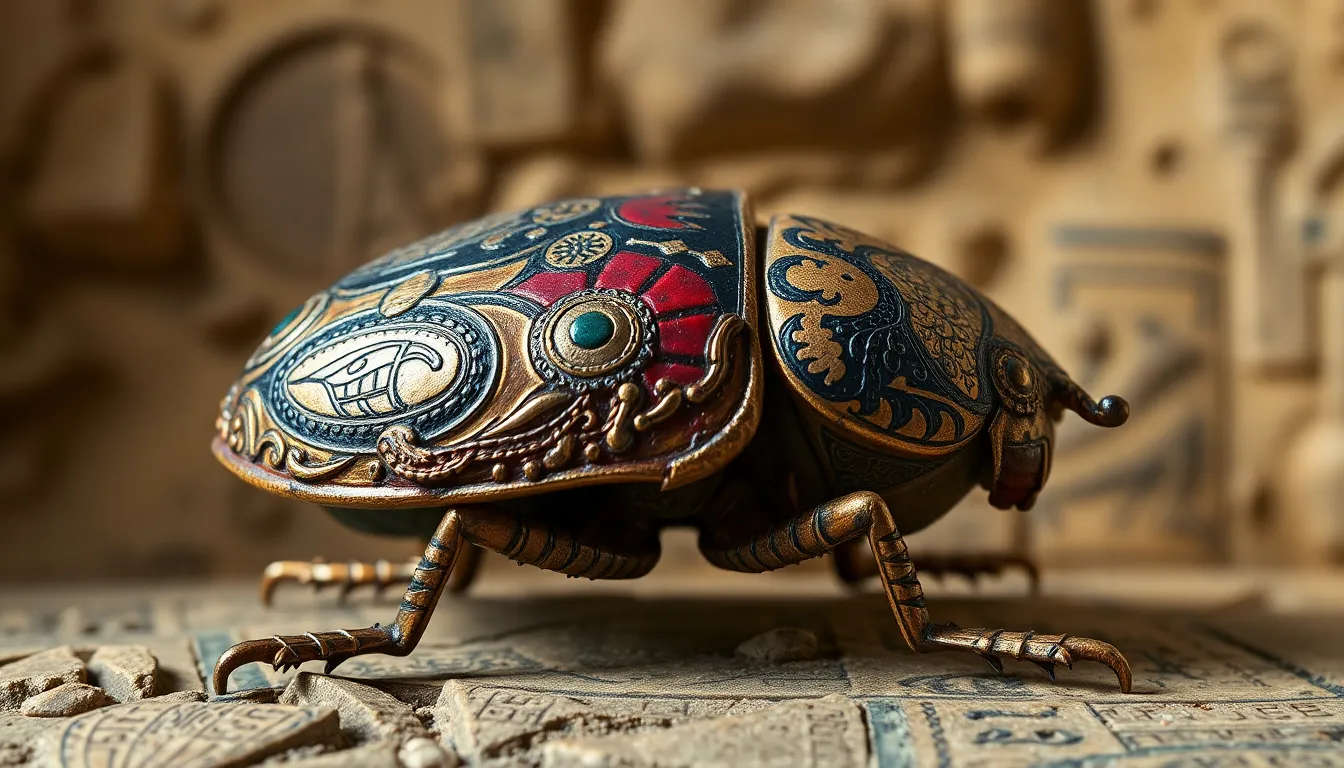The Sacred Scarab: Myths of Transformation in Ancient Egypt
I. Introduction to the Sacred Scarab
The sacred scarab, or scarabaeus sacer, holds a prominent place in Ancient Egyptian culture and mythology. This small beetle, commonly found in Egypt, was revered for its unique behavior of rolling balls of dung, which the Egyptians interpreted as a metaphor for creation and regeneration. The scarab symbolizes transformation, renewal, and the cyclical nature of life, making it an essential emblem in various aspects of Egyptian beliefs and practices.
This article delves into the multifaceted significance of the sacred scarab, exploring its symbolism, its role in mythology, funerary practices, art, and its lasting influence in contemporary culture.
II. The Symbolism of the Scarab Beetle
In Egyptian mythology and art, the scarab beetle embodies profound themes of renewal and rebirth. The beetle’s lifecycle, which includes laying eggs in dung balls that later hatch into new life, serves as a powerful metaphor for the cycle of life and death.
- Renewal and Rebirth: The scarab is often associated with the concept of resurrection, as it emerges from the dung ball, symbolizing new beginnings.
- The Cycle of Life: The scarab’s journey represents the continuous cycle of life, death, and rebirth, mirroring the natural order of existence.
III. The Myth of Khepri: The God of Creation
Khepri, one of the deities in the ancient Egyptian pantheon, is depicted with the head of a scarab. He is closely associated with the sun and is considered the god of creation and transformation.
Khepri’s role is particularly significant in the daily journey of the sun, as he is believed to roll the sun across the sky, symbolizing the renewal of life each day.
- Association with the Sun: Khepri embodies the rising sun, representing the dawn and the promise of a new day.
- Transformation and Regeneration: As a creator god, Khepri’s presence signifies the transformative power of nature and the potential for renewal inherent in all beings.
IV. Scarabs in Funerary Practices
Scarabs held significant protective qualities in Ancient Egyptian funerary practices. They were often used as amulets to guard the deceased in their journey to the afterlife.
- Protective Amulets: Scarab amulets were placed on mummies or within tombs to ensure safe passage and protection from evil.
- Burial Rituals: The scarab was integral to the burial rituals, symbolizing the resurrection of the dead and the continuation of life beyond death.
- Mummification: In the context of mummification, the scarab symbolizes the hope for rebirth and eternal life in the afterlife.
V. The Scarab in Egyptian Art and Architecture
Scarab imagery is prevalent in Egyptian art, appearing in hieroglyphics, carvings, and various artifacts. These representations serve both decorative and symbolic purposes.
- Hieroglyphics and Carvings: The scarab is frequently depicted in hieroglyphs, conveying meanings related to protection and transformation.
- Temple Designs: Scarabs are often featured in the architecture of temples and tombs, symbolizing the divine and the protective nature of the gods.
- Notable Artifacts: Many artifacts, such as jewelry and seals, showcase scarab motifs, showcasing their cultural significance and aesthetic appeal.
VI. The Scarab as a Cultural Icon
The influence of the scarab extends beyond Ancient Egypt, permeating various cultures and epochs. Its symbolism of transformation and renewal resonates universally.
- Widespread Influence: The scarab has been adopted in cultures worldwide, often symbolizing protection and good fortune.
- Later Cultures: In ancient Greece and Rome, the scarab was associated with luck and prosperity, showcasing its adaptability across cultures.
- Modern Interpretations: Today, the scarab continues to inspire spiritual and artistic expressions, symbolizing personal growth and transformation.
VII. Lessons of Transformation from the Sacred Scarab
The sacred scarab offers profound insights into personal and societal transformation. Its symbolism encourages individuals to embrace change and seek renewal in their lives.
- Personal Transformation: The scarab’s lifecycle serves as a reminder of the potential for growth and change within each individual.
- Societal Reflections: The themes of renewal and rebirth resonate with societal transformations, urging communities to evolve and adapt.
- Comparative Symbolism: Other cultures also possess symbols of transformation, such as the butterfly in Western traditions, highlighting the universal nature of this theme.
VIII. Conclusion: The Timelessness of the Sacred Scarab
In summary, the sacred scarab holds a timeless significance in Ancient Egyptian mythology and culture. It embodies critical themes of transformation, renewal, and the cyclical nature of life, influencing various aspects of Egyptian beliefs, art, and funerary practices.
As we reflect on the enduring relevance of transformation myths, we recognize the sacred scarab as a universal symbol of change and renewal, encouraging individuals to embrace their own journeys of transformation.
Ultimately, the sacred scarab reminds us of the beauty of life’s cycles and the potential for rebirth, making it a powerful emblem of hope and resilience in the human experience.




